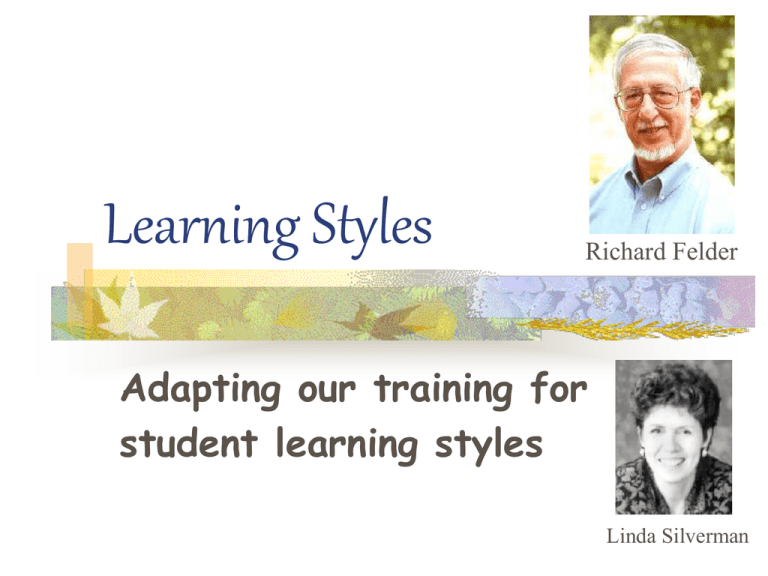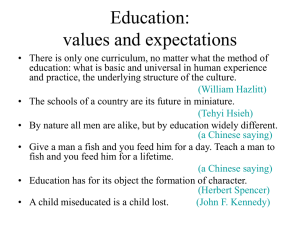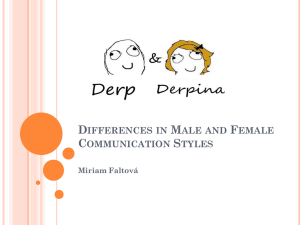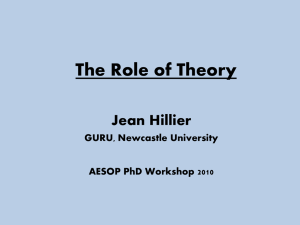Learning Styles - Felder model
advertisement

Learning Styles Richard Felder Adapting our training for student learning styles Linda Silverman How do we turn information into learning? What types of information do we perceive? How do we take it in? How do we like our information organised? How do we process it? How do we gain understanding? Preferred Learning Styles Aspect of Learning Learning Styles Perception Sensory Intuitive (concrete) (abstract) Input Visual Verbal Organisation Inductive Deductive Processing Active Reflective Understanding Sequential Global Preferred Learning Styles Aspect of Learning Learning Styles Perception Sensory Intuitive (concrete) (abstract) Input Visual Verbal Organisation Inductive Deductive Processing Active Reflective Understanding Sequential Global Perception of Information Sensory Intuitive Concrete Abstract Sights, sounds Speculation, imagination, insights Facts, data, experiments Principles, theories, symbols, concepts, relationships Sensors & Intuitors Same as in Myer-Briggs Type Indicators See www.humanmetrics.com Daydreaming? Daydreaming? Daydreaming? Daydreaming? Teaching sensors & intuitors Blend concrete information facts, data, observable phenomena and abstract information principles, theories, mathematical models Visual and Verbal Input Visual Verbal Sights Pictures Charts Symbols Sounds Words Discussions Tone of voice Stories Graphs Colours Remember what they see, especially if they draw it Remember what they hear, especially if they explain it to others Visual and Verbal Input The written word (notes or PowerPoint) is not visual but verbal Our brain translates the writing into words Visual learner Teaching visual and verbal Visual – not just text Verbal - Be expressive Pictures, diagrams, colour, demonstrations, animation, tables, graphs, graphic design Strong words, intonation, varied loudness and rhythm, stories Use multisensory Use all senses including kinesthetic Preferred Learning Styles Aspect of Learning Learning Styles Perception Sensory Intuitive (concrete) (abstract) Input Visual Verbal Organisation Inductive Deductive Processing Active Reflective Understanding Sequential Global Inductive & Deductive Organisation particulars Inductive Deductive generalities Infer principles Natural learning style Deduce consequences “Natural” teaching style Inductive-Deductive Facts, observations, events Interpret Inductive So what? Generalise Deductive Now what? Apply Inductive-Deductive Known (facts, real) Unknown (principles) Constructivism Teaching inductive & deductive learners Start with observations or problem Infer governing rules, principles, equations Deduce other implications or consequences Exercises Give phenomenon/observations Ask for underlying principles Apply theory Active and Reflective Learners Perceived information is converted to knowledge by: Active Experimentation Do something with it Discuss it, explain it Test it - experiment Reflective Observation Introspective Postulate explanations Draw analogies Formulate models Teaching active and reflective learners Active Reflective Include pauses Do both “What will the students be doing?” eg small discussion groups with report back Reflective is not passive! Active and passive teaching Active and reflective learners both need to do something – external or internal Passive teaching (eg lectures – watch and listen) suits neither! Preferred Learning Styles Aspect of Learning Learning Styles Perception Sensory Intuitive (concrete) (abstract) Input Visual Verbal Organisation Inductive Deductive Processing Active Reflective Understanding Sequential Global Sequential & Global Understanding Sequential Trees Learn progressively Linear reasoning Convergent thinking Analysis Global Forest “fits and starts” Intuitive leaps Divergent thinking Synthesis Sequential & Global Understanding Sequential Trees Learn progressively Linear reasoning Convergent thinking Analysis Global Forest “fits and starts” Intuitive leaps Divergent thinking Synthesis Homework Sequential and Global Learning Sequential and Global Learning Sequential and Global Learning Learning Pass mark Exam Time Teaching sequential and global learners Sequential Already well catered for Global Start with context and “big picture” Introduce advanced concepts early Encourage creative solutions Make them aware of their different learning style Preferred Learning Styles Aspect of Learning Perception Learning Styles Sensory Intuitive (concrete) (abstract) Input Visual Verbal Organisation Inductive Deductive Processing Active Reflective Understanding Sequential Global Models of Learning & Teaching Styles Learning Styles Teaching Styles Perception Sensory Intuitive Content Concrete Abstract Input Visual Verbal Presentation Visual Verbal Organisation Inductive Deductive Organisation Inductive Deductive Processing Student Active participation Passive Active Reflective Understand- Sequential ing Global Perspective Sequential Global Most Students Most Teachers Learning Styles Perception Sensory Intuitive Input Visual Verbal Organisation Inductive Deductive Processing * * * * * Active Reflective Understand- Sequential ing Global Teaching Styles Content Concrete Abstract Presentation Visual Verbal Organisation Inductive Deductive Student Active participation Passive Perspective Sequential Global Most Students Most Teachers Learning Styles Perception Sensory Intuitive Input Visual Verbal Organisation Inductive Deductive Processing Teaching Styles * * * * * Active Reflective Understand- Sequential ing Global Content Concrete Abstract Presentation Visual V erbal Organisation Inductive Deductive Student Active participation Passive Perspective Sequential Global Most Teaching Online Questionnaire www.engr.ncsu.edu/learningstyles/ilsweb.html So is all lost? No! Teaching for all Learning Styles Motivate learning, provide context Relate to previous material, what is to come, other subjects, student’s experience Inductive/global Teaching for all Learning Styles Balance concrete & abstract Facts, data, experiments Sensing Principles, theories, mathematical models Intuitive Teaching for all Learning Styles Balance practical & understanding Practical problem solving Sensing/active Fundamental understandings Intuitive Teaching for all Learning Styles Encourage reflection Do not fill every minute of class time Reflective Teaching for all Learning Styles Engage students Provide opportunities for activities, other than note taking Active Teaching for all Learning Styles Balance detail and open-ended Provide practice in the basics Sensing/active/sequential Provide open-ended problems that need analysis and synthesis Intuitive/reflective/global Teaching for all Learning Styles Encourage cooperation Give the option for students to work together on assignments Active Teaching for all Learning Styles Encourage failure Applaud creative solutions, even if they are wrong Intuitive/global Teaching for all Learning Styles Self-awareness Talk to students about their learning styles All





